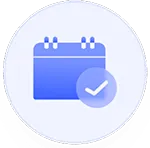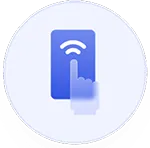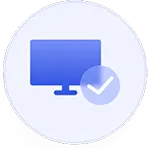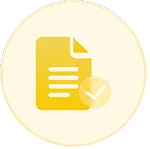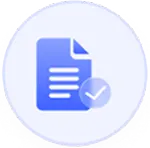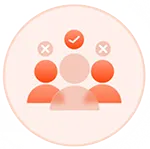- Do you find it difficult to prioritize your work in the fast-paced corporate environment of Saudi Arabia?
- Are you not getting the time for strategic planning and long-term projects due to the constant barrage of immediate demands?
- Are you looking for a practical way to take back command of your tasks and boost your productivity?
If the answer to all these questions is a yes then don’t worry you are at the right place. Envision a tool that helps you differentiate between important and urgent tasks so you can concentrate on the work where you are most needed. Imagine a system that helps you manage your tasks more effectively while simultaneously lowering stress and enhancing decision-making. So this is where the Eisenhower Matrix comes in handy.
The Eisenhower Matrix is a simple yet effective tool that has the capacity to completely change the way HR management is approached in Saudi Arabia. But now the question comes what are the benefits of using the Eisenhower Matrix for HR managers in the Kingdom, and how does it operate exactly?
Come along as we examine the transformative possibilities of the Eisenhower Matrix and dive into the area of HR efficiency. Find out how using this tried-and-true technique can help you manage your workload, make the right decisions, and drive your organization to success.
What is the Eisenhower Matrix?
The Eisenhower Matrix is a framework for making decisions that assist you in classifying your tasks according to their significance and urgency. The matrix’s primary goal is to help you find order amid chaos by directing your attention toward the things that are actually important. Another name for it is the Urgent-Important Matrix. Being able to manage your time well is a crucial ability for both your personal and professional life.
You fight for responsibilities that require your attention and complete an infinite number of tasks every day. You’re left feeling lost and not sure where to start because of this. The Eisenhower Matrix enters the scene at this point. Dwight D. Eisenhower, the 34th President of the United States, developed this simple yet efficient system that helps people prioritize their work based on importance and urgency.
How Does the Eisenhower Matrix Work?

The Eisenhower Matrix divides its tasks into four quadrants. Making a list of everything you need to do to correctly use the Eisenhower Matrix is the first step in applying it. Next, assign each task to one of the four quadrants based on its urgency and priority. Sort your jobs into the proper order after classifying them. The Eisenhower Matrix’s quadrants and usage are as follows:
Quadrant 1: Critical and Urgent
This quadrant is made up of things that should be completed immediately since they will significantly affect your goals or well-being. They should be taken care of immediately and with your full attention. Complete these duties right away to stay in control of your responsibilities and prevent any problems.
Quadrant 2: Not Urgent but yet Important
The tasks in this quadrant are generally not urgently necessary, but they are essential to your long-term goals and overall health. So, it’s crucial to schedule these chores and give them the time and attention they need to avoid them becoming critical in the future. Make time in your calendar to complete these proactive actions as a result, since this will help you achieve your long-term goals.
Quadrant 3: Not Important but Urgent
Although the tasks in this quadrant appear urgent, they typically don’t improve your long-term goals or prospects of success. They usually involve distractions or disruptions that can affect your productivity if they’re not handled appropriately. So as not to take time away from other important duties, set or assign a time restriction for these activities.
Quadrant 4: Not Important and Not Urgent
Activities in this quadrant fall into the categories of not urgent nor important. Generally speaking, they are time-wasters and distractions that ought to be reduced or avoided in favor of concentrating on more important tasks.
You can better understand where to keep your concentration by grouping work into these quadrants. This helps to prioritize key tasks and eliminate or delegate less important ones.
What are the Benefits of the Eisenhower Matrix for HR Managers?
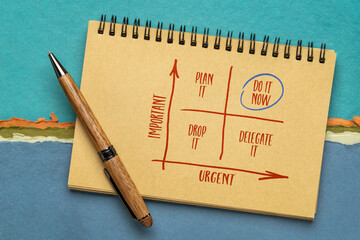
The Eisenhower Matrix offers several benefits specifically suited to the needs of HR managers in Saudi Arabia:
- Improved Ordering of Priorities: Setting priorities is essential in a fast-paced workplace where expectations are ever-changing. The Eisenhower Matrix gives you a methodical way to rank jobs according to their urgency and significance, allowing them to concentrate on the things that really count.
- Enhanced Time Management: Time is a valuable resource, particularly in human resources (HR), where demands might arise from any angle. HR managers can maximize their time by organizing their calendars and assigning assignments based on their categories.
- Decreased tension and overload: The Eisenhower Matrix gives clarity and offers a clear road map for completing tasks, which can assist reduce tension and overload. HR managers can tackle their workload with poise and confidence if they know what has to be done and when.
- Alignment on a Strategic Level: Human resources are essential to the success and strategy of an organization. HR managers can match their efforts with long-term corporate goals by concentrating on significant but non-urgent tasks like succession planning and talent development.
- Better Decision-Making: HR managers are better able to decide how best to spend their time and resources when they have a clear grasp of task priorities. Better overall performance and more effective results can result from this.
How Can HR Managers Apply the Eisenhower Matrix?
The Eisenhower Matrix implementation in HR management calls for a methodical and deliberate approach. The following are some ways Saudi Arabian HR managers might use the matrix to increase productivity and efficiency:
Start by Identifying and Sorting Tasks: Make a list of every duty and responsibility to start. Next, group each work according to its priority and urgency into one of the four quadrants.
Concentrate on Quadrant 1: Begin by tackling the urgent and significant activities in Quadrant 1. These are the things that need to be prioritized because they need to be done right now.
Set Enough Time in Quadrant 2: Allocate time for Quadrant 2 tasks, which are significant but not urgent, after addressing the urgent ones. These chores should be planned appropriately since they are essential to long-term success.
Assign or Remove Tasks in Quadrant 3: Quadrant 3 tasks—those that are urgent but not crucial—can frequently be deleted or assigned to another person. Assign work to team members who are more qualified to do it, so that time may be spent on more important duties.
Reduce Quadrant 4 Activities: Lastly, cut down on the amount of time you spend on Quadrant 4 chores, which are neither critical nor urgent. As they frequently cause distractions, these chores ought to be minimized to free up time for other important pursuits.
Some Tips for Making the Most of the Eisenhower Matrix
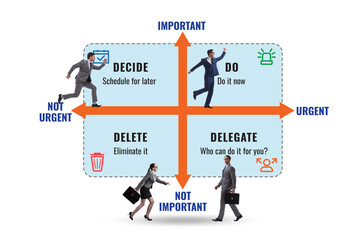
Knowing the Eisenhower Matrix’s premise is not enough to use it successfully. Here are some useful pointers to improve how you use this potent tool:
1. Color-Code Assignments to Ensure Visibility
Using a color-coded system for your tasks will greatly increase visual clarity and make it simpler to quickly identify priorities. Depending on the degree of importance, give each quadrant a distinct color.
For example, use green for urgent and significant activities, yellow for important but not urgent jobs, and so forth. You can quickly refer to this visual differentiation, which enables you to concentrate on the most important activities first.
2. Put Limits on jobs for Each Quadrant
The Eisenhower Matrix lets you divide jobs into four quadrants, but in order to prevent overload, you must keep things in balance within each group. Limiting the amount of work assigned to each quadrant will help you stay focused and make sure you’re not overcommitting to any one area.
To prevent work overload and sustain productivity, think about assigning a maximum of 5–10 tasks to each quadrant, depending on their complexity and time needs.
3. Make Different Matrices for Various Contexts:
Understand that the context and importance of your assignments will change based on whether they pertain to your personal objectives or your professional obligations. You can adjust your prioritizing strategy by making distinct matrices for various aspects of your life, such as work-related versus personal initiatives.
Partitioning your work into discrete matrices allows you to stay focused and clear in each domain without becoming bogged down by conflicting priorities.
4. Start with Task Elimination Before Prioritization:
Before you begin the process of ranking tasks in the Eisenhower Matrix, consider if there are any tasks that can be completely removed. Start by going through each item on your to-do list and marking any that don’t fit with your main objectives or priorities.
The “Not Urgent and Not Important” quadrant indicates which tasks should be eliminated first. You may speed up the process of prioritization and guarantee that your attention stays on tasks that are actually important by clearing out the clutter from your to-do list beforehand.
5. Review and Update your Matrix Regularly
The Eisenhower Matrix’s adaptability to shifting priorities and conditions makes it very effective. Develop the habit of routinely reviewing and updating your matrix to account for evolving priorities, completing tasks, and changing deadlines.
After each week or month, set aside some time to assess your progress, reassess the importance of your tasks, and make any required corrections. You can make sure that your Eisenhower Matrix is still a useful tool for increasing productivity and accomplishing your objectives by continuing to use a dynamic approach to task management.
6. Get Input and Make Adjustments
Don’t be afraid to ask for input on your work prioritization strategy utilizing the Eisenhower Matrix from coworkers, managers, or mentors. Asking for feedback from others might give you important insights into areas that you may not have thought about for improvement or blind spots.
Remain receptive to constructive feedback and be prepared to modify your prioritization tactics in response to input obtained. Enhancing your Eisenhower Matrix technique over time will help you manage your workload more effectively and efficiently.
7. Use Technology to Support Implementation
To improve your work management skills and expedite the Eisenhower Matrix implementation, make use of software applications and technology solutions. Seek for project management systems or task management programs with capabilities like priority filtering, customized task categorization, and deadline monitoring that are specially made to operate with the Eisenhower Matrix structure.
You can work more productively and efficiently by automating repetitive operations, centralizing task management, and giving you real-time visibility into your job priorities through the integration of technology into your workflow.
By using these tips you can optimize the Eisenhower Matrix for work prioritization, workload management, and increasing productivity in both your personal and professional efforts.
Conclusion
the Eisenhower Matrix is a useful tool For HR managers in Saudi Arabia looking to increase productivity, efficiency, and efficacy in handling their workload. The matrix gives HR managers an organized way to prioritize duties so they can concentrate on what really matters—achieving strategic goals and promoting corporate success.
HR managers can position themselves as strategic partners in the success of their organizations by navigating the intricacies of HR management with clarity and confidence by implementing the Eisenhower Matrix into their everyday operations and paying attention to these implementation suggestions.


